When a person wants to buy a Binocular, he gets confused about which one will be appropriate for him and which one won’t. People have different purposes for buying binoculars; some may want to use them for regular use, like sports watching, hiking, or for some holiday uses.
Before starting, we will show you some significant facts and features you should consider before buying your pair of binoculars:
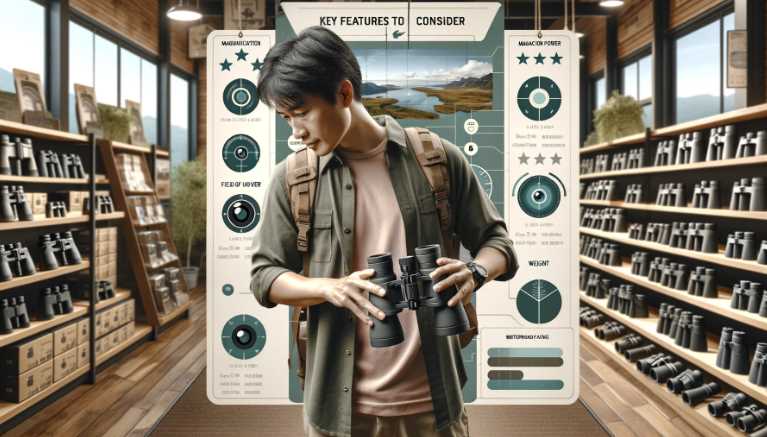
Understanding Binocular Specifications
Key Features to Consider
Embarking on the journey to select the perfect binoculars involves unraveling a tapestry of specifications, each contributing to the overall viewing experience.
1. Objective Lens Diameter
The size of the objective lens plays a pivotal role in light gathering. A larger objective lens allows more light to enter, resulting in a brighter and clearer image. However, it’s essential to strike a balance, considering that larger lenses can make the binoculars heavier and bulkier, impacting portability. For a versatile choice, opt for an objective lens diameter ranging from 42mm to 50mm.
2. Magnification Power
While it might be tempting to go for higher magnification, it’s crucial to understand the trade-offs. Higher magnification can result in a more detailed view, but it also amplifies hand movements, making it challenging to maintain a steady image. For general-purpose use, magnification power between 8x and 10x is recommended, providing a sweet spot between zoom and stability.
3. Field of View
The field of view refers to the width of the area visible through the binoculars at a specific distance. A wider field of view is advantageous, especially when observing fast-moving subjects or scanning vast landscapes. Finding the right balance between magnification and field of view is key to an immersive experience. Aim for a field of view between 300ft and 400ft at 1000 yards.
4. Exit Pupil
The exit pupil is the diameter of the light beam exiting the eyepiece. Understanding this specification is crucial for optimizing low-light performance. To ensure a bright image in various lighting conditions, select binoculars with an exit pupil diameter that matches or slightly exceeds your eyes’ dilation. A range between 4mm and 5mm is generally considered ideal.
5. Close Focus Distance
For nature enthusiasts and bird watchers, the ability to focus on close objects is paramount. A close focus distance of 6ft to 10ft allows you to observe intricate details, making your binoculars versatile for a range of activities.
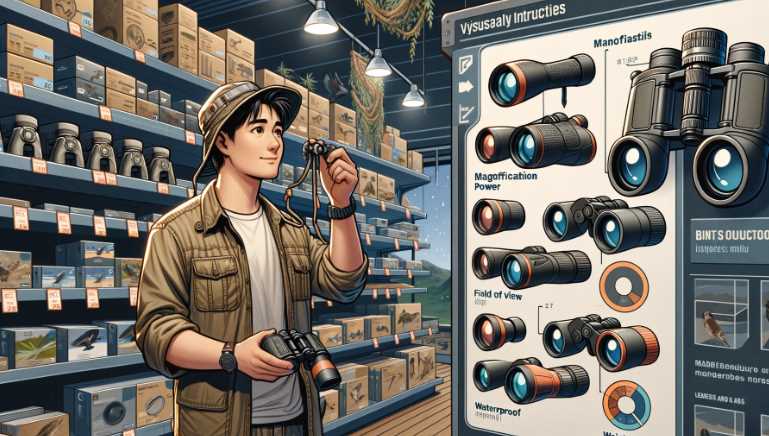
Key Binocular Specifications
| Specification | Ideal Range |
|---|---|
| Objective Lens Diameter | 42mm – 50mm |
| Magnification Power | 8x – 10x |
| Field of View | 300ft – 400ft at 1000 yards |
| Exit Pupil | 4mm – 5mm |
| Close Focus Distance | 6ft – 10ft |
In the intricate dance of these specifications lies the secret to finding binoculars tailored to your specific needs. As you consider these factors, envision the breathtaking scenes that await you, framed with precision through the lenses of your chosen binoculars.
Types of Binoculars
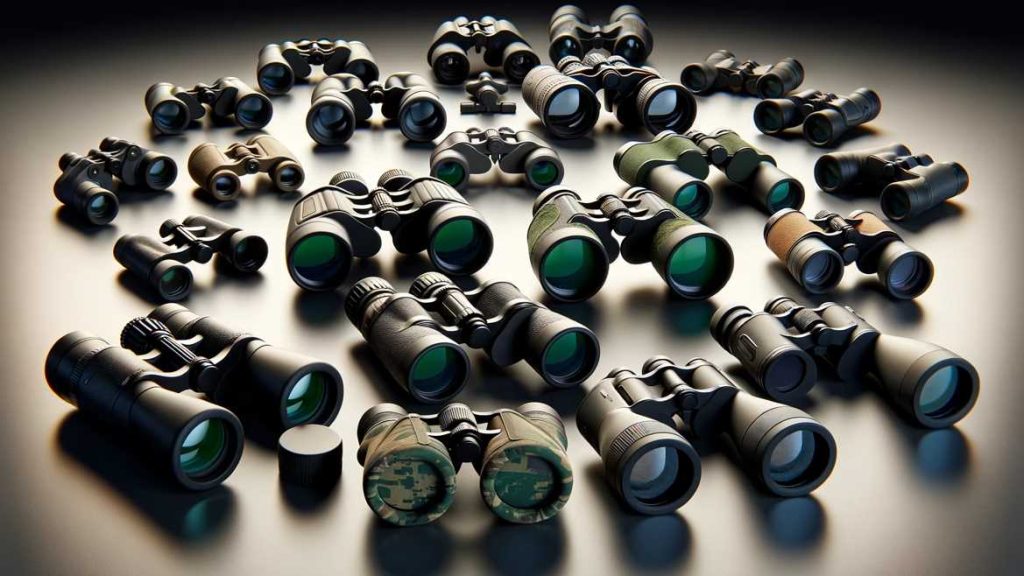
Choosing the Right Type
Selecting the type of binoculars is akin to choosing the lens through which you’ll view the world. Understanding the nuances between various types ensures you find the perfect match for your unique preferences and activities.
1. Porro Prism vs. Roof Prism
The prism design is a fundamental element influencing the shape and performance of binoculars. Porro prism binoculars have a traditional, offset design, providing enhanced depth perception. On the other hand, roof prism binoculars are more streamlined and compact, making them an excellent choice for those prioritizing portability. Consider your preferences – whether you value a classic design or a more modern, space-efficient build.
2. Compact vs. Full-Size Binoculars
The choice between compact and full-size binoculars revolves around balancing size and performance. Compact binoculars are travel-friendly, easily fitting into pockets or small bags. However, they may sacrifice some image quality compared to their full-size counterparts, which offer larger objective lenses for improved clarity. Consider your intended activities – are you seeking a travel companion or a dedicated tool for detailed observations?
3. Zoom vs. Fixed Magnification
The debate between zoom and fixed magnification revolves around versatility and stability. Zoom binoculars allow you to adjust the magnification, offering flexibility in various scenarios. However, this versatility often comes at the cost of stability, as higher magnifications amplify hand movements. Fixed magnification binoculars, while limiting in terms of versatility, provide a steadier image. Consider your priorities – do you prioritize adaptability or a rock-solid viewing experience?
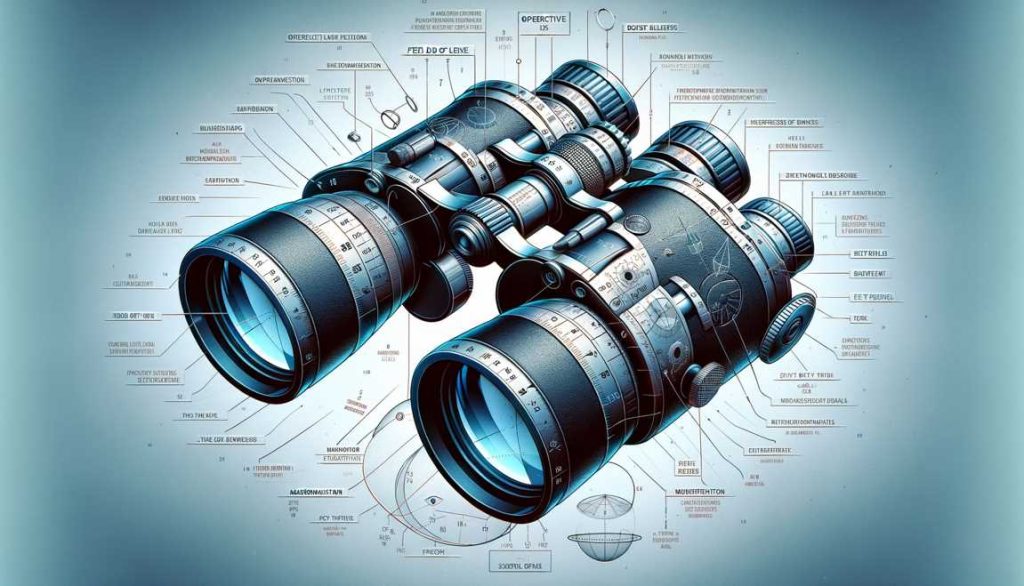
Types of Binoculars
| Binocular Type | Pros | Cons |
|---|---|---|
| Porro Prism | Enhanced depth perception | Bulkier design |
| Roof Prism | Streamlined, compact | Potentially more expensive |
| Compact | Travel-friendly | Sacrifice some image quality |
| Full-Size | Better image quality | Bulkier and heavier |
| Zoom | Versatility in magnification | Potential compromise in image stability |
| Fixed Magnification | Steadier image | Limited versatility |
As you delve into the world of binocular types, imagine the scenarios each design is tailored for. Picture yourself on a mountaintop with compact binoculars, or immersed in the details of nature with a pair of full-size binoculars.
Consideration of Lens Coatings
Coated, Fully Coated, Multi-Coated, and Fully Multi-Coated Lenses
The magic behind the clarity and brilliance of binocular vision lies in the application of specialized lens coatings. These coatings serve as the unsung heroes, enhancing light transmission, reducing glare, and ensuring that every detail is vividly captured.
1. Coated Lenses
Binoculars with coated lenses have a single layer of coating on at least one lens surface. While this basic coating provides some improvement in image quality by reducing light loss, it is considered the entry-level option in lens coating.
2. Fully Coated Lenses
A step up from coated lenses, fully coated binoculars have all air-to-glass surfaces coated with a single layer. While still a budget-friendly option, fully coated lenses provide better light transmission and improved image brightness.
3. Multi-Coated Lenses
Multi-coated lenses feature multiple layers of coating on at least one lens surface. This enhances light transmission, reduces reflections, and results in brighter, sharper images. Binoculars with multi-coated lenses strike a balance between performance and affordability.
4. Fully Multi-Coated Lenses
Considered the pinnacle of lens coatings, fully multi-coated binoculars have all air-to-glass surfaces coated with multiple layers. This comprehensive coating significantly improves light transmission, contrast, and color fidelity, ensuring a superior viewing experience even in challenging lighting conditions.
The choice of lens coatings depends on your budget, intended use, and desired level of optical performance. While fully multi-coated binoculars are the gold standard, fully coated or multi-coated options can still deliver excellent results for casual or budget-conscious users.
Lens Coating Types
| Lens Coating Type | Description | Ideal Use |
|---|---|---|
| Coated | Single layer on at least one lens surface | Entry-level |
| Fully Coated | All air-to-glass surfaces coated with a single layer | Budget-friendly |
| Multi-Coated | Multiple layers on at least one lens surface | Balanced performance |
| Fully Multi-Coated | All air-to-glass surfaces coated with multiple layers | Superior optical performance |
Evaluating Build and Design
Durability and Ergonomics
Choosing binoculars with a robust build and ergonomic design is essential for ensuring longevity and comfort during use.
- Build Material (Metal vs. Plastic)
- The choice between metal and plastic for the construction of binoculars involves a trade-off between durability and weight.
- Metal builds, often made of aluminum or magnesium alloys, provide sturdiness suitable for rugged outdoor activities but come with a higher weight.
- High-quality plastics, on the other hand, strike a balance between durability and reduced weight, making them suitable for extended use without causing undue strain.
- Waterproof and Fogproof Features
- Opting for binoculars with waterproof and fogproof features is crucial, especially for outdoor enthusiasts facing varying weather conditions.
- Nitrogen purging, a common feature, prevents internal fogging, ensuring clear vision in diverse environments.
- Waterproofing safeguards against unexpected rain or accidental submersion, making them reliable companions in all weather scenarios.
- Grip and Comfort
- The ergonomic design of binoculars contributes significantly to user comfort during extended use.
- Textured grips and well-designed contours enhance the overall handling experience, providing a secure hold and reducing the likelihood of accidental drops.
Binocular Build and Design Comparison
| Feature | Metal Build | Plastic Build |
|---|---|---|
| Durability | Excellent durability for rugged use. | Good durability with reduced overall weight. |
| Weight | Heavier due to the robust metal construction. | Lighter, ideal for extended use without strain. |
| Weather Resistance | Often equipped with superior weather seals. | Reliable in various weather conditions. |
| Cost | Higher cost due to the premium materials. | Generally more affordable without sacrificing quality. |
| Comfort | May be heavier for extended use. | Lighter design contributes to user comfort. |
This table provides a quick comparison between metal and plastic builds, aiding in the decision-making process based on individual preferences and the intended use of the binoculars. Choose the build material that aligns with your priorities, ensuring a durable and comfortable optical companion for your adventures.
Weight and Size Considerations
Balancing Portability and Performance
The weight and size of binoculars are crucial considerations that can significantly impact your overall experience, especially during extended use or travel.
- Impact of Weight on Extended Use
- The weight of binoculars directly affects comfort during prolonged use.
- Heavier models may cause fatigue, limiting the enjoyment of extended observations such as birdwatching or stargazing.
- Consider your intended use – if you plan on carrying them for extended periods, opt for a more lightweight design.
- Compactness for Travel
- Travel-friendly binoculars strike a delicate balance between compactness and performance.
- Compact models are designed for easy portability, making them ideal for activities like hiking or sightseeing.
- However, keep in mind that compactness often involves some trade-offs, such as a narrower field of view or slightly reduced image brightness.
When choosing binoculars, envision how you plan to use them. If your adventures involve a lot of movement or if you appreciate the convenience of easily stowing them in a backpack, lean towards a lighter and more compact design. On the other hand, if you prioritize optical performance and plan to set up for longer observations, a slightly heavier but more feature-rich model might be the better choice.
Adjustability and Focus System
Smooth Adjustments for Precision
The adjustability and focus system of binoculars are critical factors that contribute to the clarity and ease of use during observations.
- Central Focus vs. Individual Eyepiece Focus
- Central Focus: Convenient for quick adjustments, central focus systems simultaneously adjust both barrels with a single mechanism.
- Individual Eyepiece Focus: Ideal for more precise customization, allowing independent adjustment of each eyepiece to accommodate differences in vision between the eyes.
- Diopter Adjustment
- Diopter adjustment is a valuable feature for users with varying eyesight.
- This individualized setting compensates for the differences between your eyes, ensuring a sharp and focused image without the need for constantly readjusting the central focus.
- Twist-Up Eyecups for Eyeglass Wearers
- Twist-up eyecups are designed for flexibility, accommodating users with or without eyeglasses.
- By twisting the eyecups up or down, users can achieve the optimal distance between the eyepiece and their eyes, ensuring a comfortable viewing experience.
Binocular Adjustability and Focus System Comparison
| Feature | Central Focus System | Individual Eyepiece Focus System |
|---|---|---|
| Ease of Use | Quick and convenient adjustments. | Precision customization for individual preferences. |
| Diopter Adjustment | May have a diopter adjustment but often less customizable. | Allows for individualized diopter adjustments for each eyepiece. |
| Eyeglass Wearers | Might require additional adjustments for eyeglass wearers. | Ideal for eyeglass wearers with adjustable eyecups. |
| Suitability | Well-suited for general use and quick observations. | Preferred for activities requiring fine-tuned adjustments. |
| Common Use Cases | Birdwatching, sports events, and general observations. | Stargazing, wildlife photography, and activities requiring precise focus. |
This table serves as a quick reference guide to help you choose between a central focus system and an individual eyepiece focus system based on your preferences and specific needs.
Low Light Performance
Twilight Factor and Exit Pupil
Optimizing low light performance in binoculars is crucial for activities like stargazing or dawn and dusk observations.
- Understanding Low Light Conditions
- Twilight factor is a key consideration for low light performance, taking into account both magnification and objective lens diameter.
- Higher twilight factors, calculated by multiplying magnification by the square root of the objective lens diameter, indicate better performance in low light conditions such as dawn or dusk.
- Ideal Specifications for Low Light Observation
- Choosing binoculars with a larger objective lens diameter enhances low light performance.
- A larger exit pupil, calculated by dividing the objective lens diameter by the magnification, is advantageous for low light conditions, providing a brighter and clearer image.
Binocular Low Light Performance Comparison
| Feature | Larger Objective Lens Diameter | Larger Exit Pupil |
|---|---|---|
| Advantages | Enhanced light-gathering ability. | Brighter image in low light conditions. |
| Twilight Factor Calculation | Higher twilight factor for improved performance. | Considerable impact on low light observations. |
| Low Light Scenarios | Ideal for dawn, dusk, and stargazing. | Excellent performance in dimly lit environments. |
| Common Magnification Ranges | Often found in lower magnification ranges. | Compatible with various magnification options. |
| Suitability | Well-suited for activities requiring extended low light observations. | Versatile for different low light scenarios. |
This table provides a comparative overview, allowing you to assess the impact of larger objective lens diameter and exit pupil on low light performance. Consider your specific use cases, especially if you anticipate engaging in activities where optimal performance in low light conditions is essential.
Setting a Budget
Finding the Balance
While the allure of high-end binoculars is undeniable, setting a realistic budget is crucial for a satisfying purchase.
- Price Range for Different Needs
- Entry-level binoculars can offer excellent value for casual users, providing adequate performance for general observations.
- Higher budgets unlock advanced features, superior optics, and durable builds, catering to the needs of enthusiasts and professionals.
- Balancing Features and Cost
- Assess your priorities and align them with your budget.
- Consider features that are essential for your specific activities to find a balance between performance and cost.
Binocular Budget Considerations
| Budget Range | Features and Considerations |
|---|---|
| Entry-Level (<$200) | – Suitable for casual users and beginners. |
| – Adequate performance for general observations. | |
| Mid-Range ($200-$500) | – Improved optics and build quality. |
| – Suitable for enthusiasts seeking enhanced performance. | |
| High-End (>$500) | – Advanced features, superior optics, and durable builds. |
| – Ideal for professionals and those with specific requirements. |
This table provides a quick overview of budget considerations, helping you align your financial investment with the features that matter most to you.
Maintenance and Care Tips
Prolonging the Life of Your Binoculars
Investing in binoculars is not just about the initial purchase; it’s a commitment to their care and maintenance. Proper handling and routine maintenance ensure that your binoculars provide clear and crisp views for years to come.
- Cleaning and Storage Guidelines
- Use a lens cleaning kit designed for optics to remove dust, fingerprints, and smudges gently.
- Avoid using abrasive materials like tissues or clothing that may scratch the lenses.
- Blow away loose particles before cleaning to prevent scratching.
- Store binoculars in a protective case when not in use to shield them from dust, moisture, and accidental damage.
- Keep the lens caps on when not actively using the binoculars to prevent dust accumulation.
- Avoiding Common Mistakes
- Refrain from touching the lenses with bare fingers as natural oils can degrade lens coatings.
- Be cautious when adjusting the interpupillary distance, ensuring smooth movements to avoid strain on the hinges.
- Avoid exposing binoculars to extreme temperatures, as rapid changes can lead to internal fogging.
- Regularly check for any signs of wear and tear, such as loose screws or misaligned optics.
- If binoculars get wet, wipe them dry immediately to prevent water damage, and allow them to air-dry completely before storing.
Binocular Maintenance and Care Tips
| Maintenance Task | Recommended Action |
|---|---|
| Cleaning Lenses | – Use a lens cleaning kit for gentle and thorough cleaning. |
| – Avoid abrasive materials and ensure lenses are dust-free before cleaning. | |
| Storage Practices | – Store binoculars in a protective case to shield them from dust and moisture. |
| – Keep lens caps on when not in use to prevent dust accumulation. | |
| Handling and Adjustment | – Be cautious when adjusting interpupillary distance to avoid strain on hinges. |
| – Check for signs of wear and tear, such as loose screws or misaligned optics. | |
| Temperature Considerations | – Avoid exposing binoculars to extreme temperatures to prevent fogging. |
| Dealing with Moisture | – Wipe binoculars dry immediately if they get wet; allow them to air-dry completely. |
| Avoiding Fingerprints | – Refrain from touching lenses with bare fingers to prevent oil buildup. |
This table serves as a practical guide to maintaining and caring for your binoculars, ensuring their longevity and optimal performance. Incorporating these simple yet effective practices will help you get the most out of your investment and continue enjoying clear and vibrant observations.
Facts & features you need to consider before choosing:
| LENS SIZES | MAGNIFICATION NUMBER | PRISM TYPE | IMAGE QUALITY |
| FIELD OF VIEW | EYE RELIEF NUMBER | EXIT PUPIL NUMBER | PURPOSE OF USE |
| OPTICAL COATING | FOCUS QUALITY | SIZE & WEIGHT | RUBBER COATING |
| BRAND | COST | DURABILITY | ACCESSORIES |
Significance of Binocular Numbers & Terminologies:
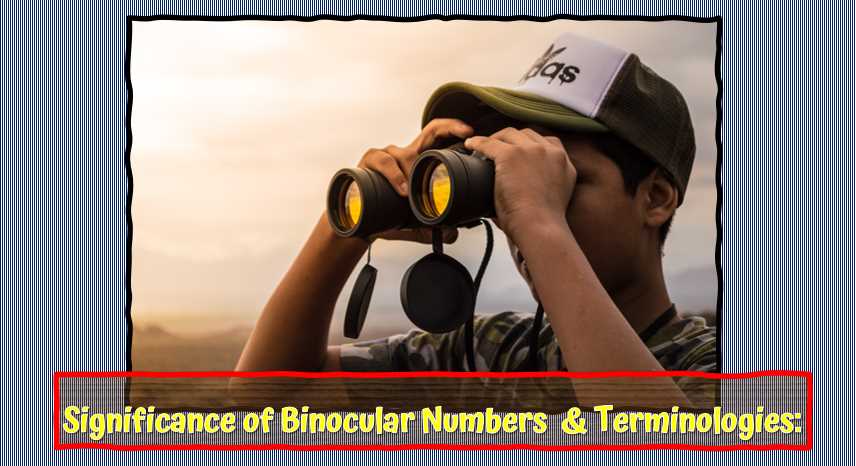
You will see some numbers on Binoculars. These are significant numbers, and you also need to know some technical terminology of binoculars. Here, we will give a good idea about them. We will try to explain it quickly; thus, you can get it easily.
NUMBERS & TERMINOLOGIES YOU MUST KNOW BEFORE CHOOSING
| Magnification Number | In a 10×60 Binocular, 10x is the magnification number. You will see the image ten times closer than its actual distance. More magnification power decreases stability, and an unstable focus can reduce image quality. |
| Objective lenses | The number after the magnification number defines the objective size. For example, in a 10×60 Binocular, the accurate mirror is 60mm. The bigger objective lenses make the image brighter, and even when viewing the night sky, it produces a more brilliant image quality. |
| Prism Type | Two types of prisms are designed for binoculars, such as PORRO PRISM and ROOF PRISM. Roof prism binoculars are relatively modern, whereas Porro prism binoculars are older versions. Binoculars with roof prisms are more compact binoculars than the Porro ones. Because they use some single straight prism, on the other hand, the Porro is not straight. |
| Exit – Pupil Number | The exit-pupil number is the amount of light that allows you to see that item you want to notice from the binoculars. The exit-pupil number should be more than 4. |
| FoV | FoV -Field of view is the image size or the number of horizontal photos you can watch from your Binoculars. More than 300 feet is an average viewing field from a binocular. A wide field of view is always better for finding objects. There is the angle of view also in a pair of binoculars. The field of view and angle of view determines the same amount of horizontal space. |
| Eye Relief Number | If you wear glasses, this number is essential to you. The eye-relief number should be at least 15mm. This number matches the distance between your eyes and the binocular eyecups. It is also called eye relief distance. |
We will start with the general uses, and then one by one, we will guide the definite and professional users.
BINOCULARS FOR EVERYDAY NORMAL USES
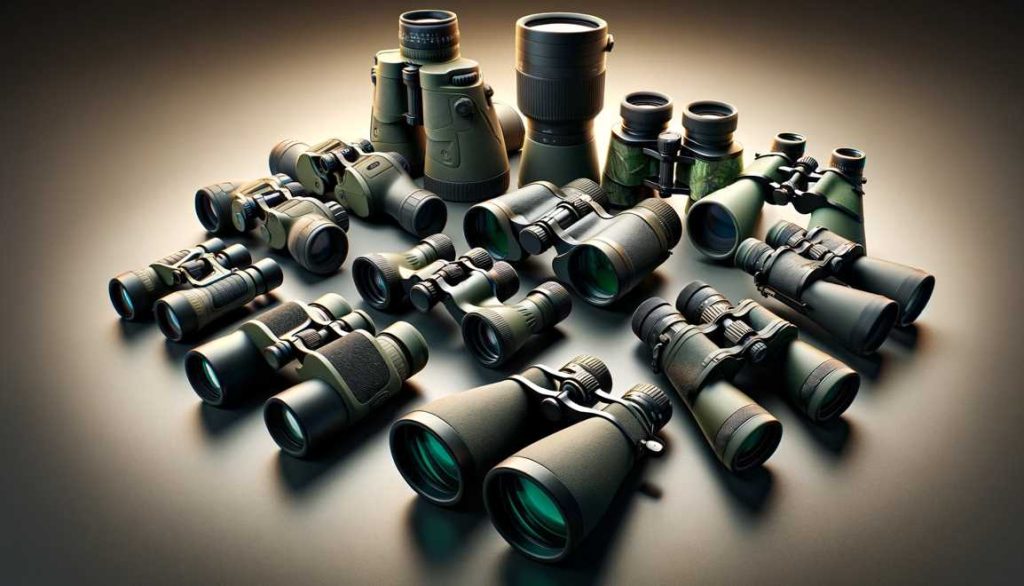
| Magnification Number | 8x magnification is perfect for close focus, like hiking or sports watching in the stadium, but for cinema watching in a cinema hall, 7x magnification is enough. Though you can use an 8x magnification binocular in the cinema hall. So, 8x magnifications are the best option for your general uses. |
| Objective lens | For general uses, the lens size should be less than 30mm. An 8×28 pair of binoculars will be best for everyday use. |
| Other important facts: FoV, Exit-pupil number | The average FoV(field of view) should be 300 feet or more and should be durable. We recommend you buy the water-resistant binoculars version if you can afford it. 8×28 versions will be the best for general use. |
How to Choose Binoculars for Birding?
| Magnification Number | An 8x magnification number is the best for bird watchers. But you can also take a 10x version if you are an expert user because higher magnification needs an expert hand to keep it stable. |
| Objective lens | 42mm is the best lens size for bird watchers. So, an 8×42 binocular is an excellent choice for bird-watching. |
| Other important facts: Fov, Exit pupil number | Three hundred thirty feet is the best field of view for bird watching. It will be easier for you to track any birds with that amount of field of view. Find a durable one with perfect features. |
How to Choose Binoculars for Wildlife-viewing or Hunting?
| Magnification Number | 8x to 10x is better for hunting. 8x magnification is perfect for many people, whereas you can choose a higher magnification version, like 10x, if you want to use it from more distance. Sometimes, you may need more magnification. Thus, an 8×32, 8×42, or 10×42 is the best option. You have to choose according to your needs. |
| Objective lenses | 32mm – 42mm is the perfect size for wildlife viewing or hunting. It also depends on your needs; if you want to use it in poor light conditions, you need bigger lenses. On the other hand, for daylight, you can use 32mm enough. |
| Other important facts: Fov, Exit pupil number | An average FoV of 300-375 feet is enough. But if you need more or less FoV, you can take it and choose the appropriate angle of view. Try to buy fog proof and waterproof binoculars. It will be best for rough uses if you can get or afford a multi-coated binocular. Find the best brand which will give you the best quality at an affordable price. |
How to Choose Binocular For Boating?
| Magnification Number | 7x magnification is the ideal size for Marine uses. Because a ship or a boat is never steady. That’s why, even If you use any support to make your binoculars stable, you will not succeed. So for better image stabilization, we recommend you use lower magnification. |
| Objective lenses | 50mm is a standard and ideal accurate size. A 7×50 binocular will be the best for boating and Marine uses to get better image quality. |
| Other important facts: Fov, Exit pupil number | 385-foot FoV is better for boating or Marine uses. Find the best brand, depending on how much you want to spend. Make sure that your models are waterproof binoculars. As you wish to use them for boating, waterproof binoculars and multi-coated versions should be your priority. |
How to Choose Binoculars for Skywatching or Astronomy?
| Magnification Number | 8x to 10x is the average good magnification number for beginners. It will give you a good night sky viewing experience. Better eyepiece lenses (ocular lenses) are suggested for astronomy binoculars because you will not use your binoculars for astronomy at close focus. |
| Objective lens | 50mm and 56mm are better for beginners, giving a satisfactory result with bright images. Consequently, 8×56 and 10×50 are the best options because they have larger lenses and the right ocular lens size. On the other hand, if you are an expert sky-watchers and want some intense results and want to have binoculars for astronomy unique experiences, the 25×100 binoculars are recommended. Astronomy binoculars have more considerable magnification power because their ocular lens (eyepiece) is more powerful and has a bigger objective size. |
| Other important facts: Fov, Exit pupil number | A field view of 300 feet is enough for astronomy binoculars. You have to use a stand or tripod to get stability. If you want to use it roughly, we suggest buying multi-coated and water-resistant binoculars. Find the best quality according to your price range. |
10 Things to consider when Buying Binoculars
You should consider a few things when buying binoculars, including your level of expertise and the type of activities you will use them for. Top-of-the-line optics may not be necessary if you’re an expert hunter or fisherman. However, if you plan on using your binoculars to see wildlife or scenic views while hiking or traveling, better optics will make the experience more enjoyable.
Size and weight
Binoculars come in different sizes and weights, so it’s essential to find the right pair. Generally, the larger the binoculars are, the brighter they will be. Smaller binoculars are also perfect for close-up viewing or use when hiking or camping.
Regarding weight, heavier binoculars are usually better because they will stay on your head when you look through them. They won’t bounce around as much, so you’ll have less trouble seeing what you’re looking at. Additionally, a heavier binocular will typically take more time to become foggy or blurry, so you’ll be able to see more detail overall.
Field of view
Paying attention to the field of view (FOV) is essential. This is the area in which you can see clearly. The higher the FOV, the more details you’ll be able to see.
Some binoculars have a wide FOV, while others have a narrow FOV. It’s essential to choose the right type of binoculars for your needs. If you’re planning on using them for hunting or bird watching, you’ll want a wide FOV binocular because it will give you a better overall view. If you’re using them for general observation, then a narrower FOV will be more appropriate.
Types
Binoculars come in different types of lenses and strengths:
Monoculars are just glasses that allow you to see one image at a time. They’re suitable for viewing close-up objects or for reading documents.
Binoculars provide an enhanced view by splitting the image into two separate images that can be viewed separately. They’re ideal for viewing larger objects and landscapes.
Telescopic binoculars have a long lens that allows you to see further away. They’re best suited for viewing wildlife or distant scenery.
Multi-purpose binoculars allow you to use them for different purposes, like birdwatching or hunting. They have a wide range of magnifications for close-up and distant viewing.
Batteries
Low-quality batteries can cause the optics to become foggy, reducing your visibility when looking through them. Worse yet, if the battery pack is defective, it could explode and cause serious injuries.
So how do you know if the batteries in your binoculars are of high quality? The best way to check is to take them into a shop and have them tested. Alternatively, you can try them by putting them into a flashlight and seeing if the light goes out.
If the binoculars work correctly with a flashlight, they’re likely good enough for outdoor use. However, if they don’t work with a flashlight, it’s best to replace the batteries with better ones.
Eye cups and adjustments
Knowing the different types of eyecups and their corresponding adjustments is essential. Here are a few things to keep in mind:
– Monoculars have one eyepiece that you look through, while binoculars have two.
– Eye cups on monoculars are typically smaller than those on binoculars, which translates to a more immersive experience.
– The size and shape of the eye cups also affect how well they fit your eyes. If your eyes are close together or more prominent in diameter than average, you’ll want to get binoculars with large eye cups to accommodate these characteristics.
– Most monoculars have a focusing ring that controls the distance between the viewer and the observed object. This ring is usually located near the eyepiece; however, some models come with a built-in focuser separate from the eyepiece.
– Most monoculars also have a diopter (or dioptre) adjustment that allows you to correct for poor vision at different distances.
– Binocular straps can make it easier to hold onto your binoculars while observing; they can also help distribute weight evenly across your shoulders so that you don’t fatigue as quickly as possible.
Tripods and mounts
A tripod is an essential piece of equipment for anyone who wants to use binoculars for observation. It helps stabilize the binoculars so that they are not constantly moving, which gives you a steadier view and makes it less likely that you’ll miss something important.
There are a few different types of mounts available, but the two most popular ones are bolt-on mounts and rifle scopes mounts. Bolt-on mounts are quick and easy to use, but they can be bulky and require some drilling or mounting skill. Rifle scope mounts are more compact and easier to use, but they may not be as stable as bolt-on mounts.
whichever type of mount you choose, make sure that it is compatible with your binoculars and your specific shooting style. It’s also essential to make sure that the mount can hold your weight; if it can’t, it may not be able to keep up with your movements when you’re looking through the binoculars.
Warranty and support
Binoculars come with a warranty that covers defects in the glass or optics, but it’s important to know what type of warranty is offered. Some warranties only cover defects caused by manufacturing or design flaws, while others cover any imperfections.
It’s also important to know what kind of support is available should you need it. will the manufacturer be able to help you fix your binoculars if they’re not working correctly? Will they be able to provide advice on how best to use them?
Overall, it’s a good idea to research the warranty and support offered by a particular brand before making a purchase. This way, you’ll have peace of mind knowing that you’re getting a product that will last and be easy to use.
Lens coating
This protection that’s applied to the lenses to prevent them from coming into contact with dirt, dust, and other elements.
There are a few different types of lens coatings, and each has its benefits and drawbacks. One popular type is anti-reflective coating, which helps reduce glare and improves visibility in low-light conditions. There are also water-repellant coatings that help keep water off the lenses, preserving them against damage from rain or moisture.
The best way to find out what kind of lens coating your binoculars have is to look for it on the product packaging or online reviews. If you’re unsure, it’s always worth getting a second opinion from a friend or family before making your purchase.
Portable and Waterproof Rating
When you’re looking to buy binoculars, make sure that they are portable and water-resistant. This is especially important if you plan on taking them hiking or camping.
Another thing to consider is the Waterproof rating. Make sure that the binoculars you purchase have a rating of IPX8 or higher to protect them from rain, splashing water, and even immersion in up to two meters of water for up to 30 minutes.
Optical quality and Magnification
Optical quality measures how clear and sharp the images are in your binoculars. High-quality binoculars will produce images that are clear and free from distortion, which makes it easier to see details.
Magnification is the power of your lenses to magnify distant objects. The higher the magnification, the closer you’ll be able to see things. However, too much magnification can also lead to problems like eyestrain and headaches. So, ensure you find a pair of binoculars with the correct magnification.
PRISM: Which prism should you choose, PORRO or ROOF?
It depends on your demands and your budget. If you want lightweight and compact Binoculars, a roof prism will be better for you. On the other hand, if you don’t want to spend too much money, you are a budget buyer; the Porro prism will be better because the roof prism is more expensive than the Porro prism.
Last Words:
We are all budget buyers. We all want the best quality in our budget. We think that you also want the best binoculars within your budget. Now you know choosing binoculars according to your needs. So, first of all, find out which brand gives you the best quality at an affordable price. Then select a binocular in pursuance of your choice, considering all its features. First, look for durable, rubber-coated, weather-resistant binoculars with larger exit pupils, good optical design, sharper focus, a right angle of view, and produce quality images. Finally, buy your favorite Binocular. After purchasing, always use a neck strap for your binoculars’ safety and a lens cleaner to betterment your binoculars.

I am an enthusiastic student of optics, so I may be biased when I say that optics is one of the most critical fields. It doesn’t matter what type of optics you are talking about – optics for astronomy, medicine, engineering, or pleasure – all types are essential.
Last update on 2025-10-08 / Affiliate links / Images from Amazon Product Advertising API
Table of Contents




Pingback: How To Adjust Binoculars: A Complete Guide to Getting Perfect Viewing Experience with Double Vision
Pingback: What Do the Binocular Numbers Mean: Ultimate Guide to Know the Binocular Numbers and Terminology
Pingback: A Complete Beginner's Guide to Using Binoculars: Here are the 12 best Tips I've found
Pingback: Can you use binoculars with glasses?
Pingback: Are binoculars bad for your eyes? (Video Explained)